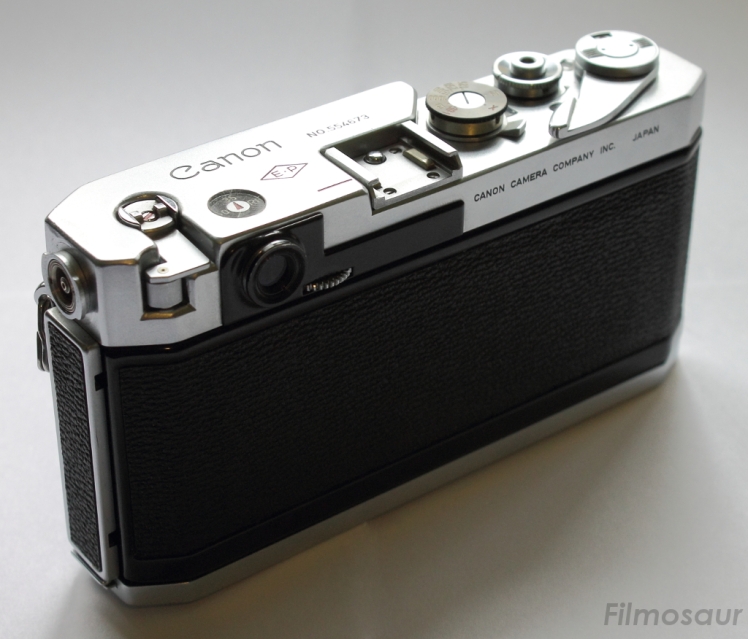Here we go again. I’ve rationalized so many camera purchases here I’m sure it’s becoming tedious to read my long-winded explanations, so here’s the short version: Canon P shutter started acting up just before a planned shoot. After servicing it, I decided I needed a backup LTM body. An L1 came up for sale at a reasonable price. I bought it. Brief enough for you?  Anyway, on the camera. The L1 is a V-series Canon RF body derivative, placing it one generation before the P. There are a few differences in detail, but the bodies are dimensionally similar and the controls are laid out essentially the same way on both. Instead of the P’s fixed viewfinder with multiple framelines, the L1 has an adjustable viewfinder with settings for 35 and 50mm lenses as well as a magnified setting designed for precise focusing. Where the P has a single shutter speed dial, the L1 has the older arrangement of two dials, one for high speeds on top and one for low speeds on the front. The shutter speed dial on the L1 also rotates, whereas the one on the P does not. The frame counter on the L1 counts down and requires manual resetting, while the P’s resets itself when the back is opened and counts up. The P has steel shutter curtains while the L1’s are cloth. That’s about it for the differences – they are fundamentally very similar cameras.
Anyway, on the camera. The L1 is a V-series Canon RF body derivative, placing it one generation before the P. There are a few differences in detail, but the bodies are dimensionally similar and the controls are laid out essentially the same way on both. Instead of the P’s fixed viewfinder with multiple framelines, the L1 has an adjustable viewfinder with settings for 35 and 50mm lenses as well as a magnified setting designed for precise focusing. Where the P has a single shutter speed dial, the L1 has the older arrangement of two dials, one for high speeds on top and one for low speeds on the front. The shutter speed dial on the L1 also rotates, whereas the one on the P does not. The frame counter on the L1 counts down and requires manual resetting, while the P’s resets itself when the back is opened and counts up. The P has steel shutter curtains while the L1’s are cloth. That’s about it for the differences – they are fundamentally very similar cameras.  The viewfinder is the biggest difference in actual use. I’ve read a number of times that many people prefer the rotating VF for 35mm lenses because the framelines on the P are way out at the edges and can be hard to see. I can see the validity of the argument, as it is easier to see the full frame on the L1, though I have used the P with a 35mm without real problems. I also prefer the 1:1 view of the P, especially for street shooting. The magnification for precision focusing is a nice feature, however, and it is also conveniently quite close the view of a 135mm lens.
The viewfinder is the biggest difference in actual use. I’ve read a number of times that many people prefer the rotating VF for 35mm lenses because the framelines on the P are way out at the edges and can be hard to see. I can see the validity of the argument, as it is easier to see the full frame on the L1, though I have used the P with a 35mm without real problems. I also prefer the 1:1 view of the P, especially for street shooting. The magnification for precision focusing is a nice feature, however, and it is also conveniently quite close the view of a 135mm lens.  Craftsmanship is typical 1950s Canon, which is to say it’s built like a tank. Heavy brass construction, solidly weighted controls, and a sense that you could use it as a hammer in a pinch. The L1 was one of a pretty wide model range at a time when the models changed frequently – the net result is that fewer than 8,000 were built.
Craftsmanship is typical 1950s Canon, which is to say it’s built like a tank. Heavy brass construction, solidly weighted controls, and a sense that you could use it as a hammer in a pinch. The L1 was one of a pretty wide model range at a time when the models changed frequently – the net result is that fewer than 8,000 were built.
My plan for the L1 is to use it alongside the P. If I need both B&W and color, I’ll load one with each; if I need 35 and 50mm lenses, I’ll set them up that way (the L1 is wearing my Canon 35/2.8 in these photos). If I want longer lenses, the P has 100mm framelines that work well with my 90/4 Elmar, while the L1’s magnifier setting should serve well with my Nikkor 135/3.5. No matter how they’re set up, the cameras are similar enough that you can use them interchangeably without much thought, but different enough that it’s easy to tell which is which.